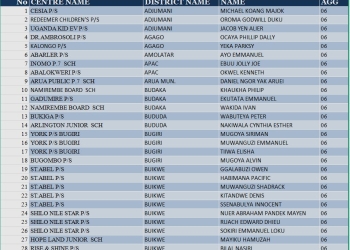What if this was to go on for a year? — A resilient city is generally one that is able to absorb or survive any shock or trauma on its physical infrastructure, economy and its social fabric. Urban areas are centres of hope to the rich, the poor and even governments.
A city’s resilience level is never static; it changes from time to time, depending on what interventions and strategies there are, and how they are effectively implemented and monitored. It is also more about what happens in that city over a period of time, what it is fed on, how it sleeps, how its dwellers interact, how attached they are to it and how it is being governed. A city is best seen, managed and governed as a system; where each component and the relationship between components matter to the technocrats, the politicians and the general public.
It is wise for nations to have national resilience strategies, which ultimately should guide urban authorities. It is important for urban centres to do vulnerability mapping to enable the process of integrating their plans with the national resilience strategy.
The COVID-19 pandemic has sent the globe into shock, and mobility has been obviously and severely affected as most guidelines prohibit movement while encouraging and forcing people to stay home. In terms of urban mobility, Uganda has taken some very drastic measures like closing Entebbe International Airport, banning public transport and eventually banning private cars, among other measures.
One can only imagine the courage President Museveni needed to ban public transport, limit the movement of boda bodas, and also ban the movement of private cars. Public transport, particularly 14-seaters taxis and boda bodas do not only ‘move’ Kampala, but they also feed it. They feed their operators (owners, drivers, conductors, stage managers, touts), plus move people to work, to school and to markets for food, among other daily activities. They, particularly, live from hand to mouth and depend on their daily earnings for survival.
Due to their extreme informality, most of these are unable to have formal contracts with their employers, and that means their source of livelihood is extremely uncertain. Vulnerability in this is both social and economic, and could easily get political. It is a fault line, which has been exposed, and the pressure is being turned to government to provide for them, lest they die of hunger or if they survive, lose their civic pride-imagine queuing and fighting for food, and are being recorded, for the whole world to know/see; that you couldn’t survive during the COVID-19 traumatic period. In some cases, social distancing cannot be a priority, but grabbing some little food is; understandably. It’s time to formalize the informal; re-organize and modernize these systems.
For a car-centric city that Kampala is, several motorists were unable to move since the effecting of the private car ban. A good number of people have opted for bicycle transport and walking. But how ready was our city for alternative means of transport? Socially the attitude towards walking and cycling has been negative, and that means it may not have been an easy decision for city dwellers to opt for this mode of transport-moreover, without supportive infrastructure.
Junctions and highways are particularly crucial for the safety of bicycle riders. What if this lockdown situation was to go on for a year? How would we avoid the spread of #COVID-19 while in transit? Are we ready to move our city by walking and cycling? If this turns out to be the case, those who live close to their workplaces and schools, for instance, might be lucky to pick up their lives and normal schedule.
However, those who have longer commuter distances will find it difficult to cope with not only a new walking and cycling experience but also the long distances. I don’t want to imagine our population riding and walking to and from work daily, for say, a total distance of 40 Km, on terrible and dangerous road infrastructure. This is yet another big fault line testing the resilience of our urban areas, especially, Greater Kampala.
It is no secret that our major land uses (housing, work, schools, social places, etc), lack a meaningful relationship and aren’t self-sustaining. Some places are typically sleeping areas, while others have excesses in terms of service provision and densities.
However, this is also a big opportunity for post-COVID-19. It may easily result in park and ride travel; whereby safe public car parking is available for motorists wishing to access the city centre to park their cars and take public transport or walk and ride bicycles.
Besides reducing traffic congestion and air pollution, this would come with new opportunities like employment; managing the public car parking, public bike sharing, banking services, establishment of cafes and restaurants, and socially, as an opportunity for people to meet and interact.
We have also realized that as a city we have no mechanism of ensuring fresh food availability for the dwellers. Is it time to rethink urban agriculture, especially at the periphery of our urban areas? What about encouraging home gardening for fresh foods, particularly vegetables? What if all this was to go on for a year?
Obviously, there’s a big difference between our rural areas and urban areas in terms of service provision and employment opportunities. This makes life in urban areas more attractive but unfortunately only in the short term, more so for those in the informal sector. What our government ought to know is that life isn’t all about food and sleep. It’s about employment, education, health and comfortable social life. We can’t keep our rural Uganda in its current state of just food and sleep, while attracting the poor to urban areas, only to live from hand to mouth.
This, in such times, is not only life-threatening to the urban poor but also a burden to government. It is also a loss in terms of economic productivity. It is high time rural Uganda is given due and aggressive attention in terms of urban development priorities, creation of real employment, through industrialization, modernization of agriculture and promotion of tourism. This will not only enable balanced regional growth but will also limit the number of people getting attracted to urban areas for a vulnerable and deceptive better life.
Nevertheless, COVID-19 should serve as an eye-opener, that we always need various ways of doing things otherwise we shall never have the ability to absorb such shocks. What if this was to go on for a year? How ready is Greater Kampala?
====================================================================
This writer, Amanda Ngabirano is an urban and regional planner, lecturing at Makerere University, in Uganda

















